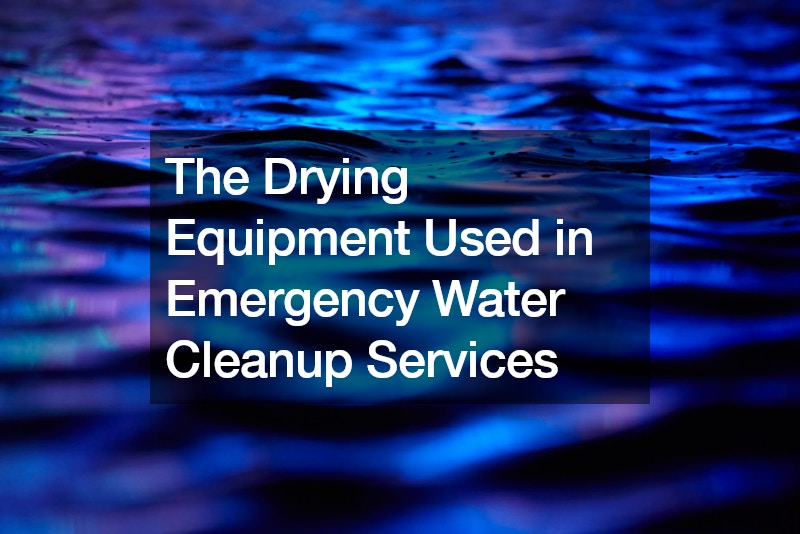In the aftermath of water damage, whether from a burst pipe, flooding, or any other source, swift action is essential to mitigate further damage and restore affected spaces. Emergency water cleanup services play a pivotal role in this process, employing various drying equipment to expedite the restoration process effectively.
The Risks Associated With Water Damage
Water damage poses significant risks to both property and health, making prompt mitigation crucial in emergency water cleanup services. Here’s an elaboration on the dangers associated with water damage:
- Structural Damage: Water can wreak havoc on building materials, weakening structures and compromising their integrity. Wood, drywall, and insulation are particularly susceptible to water damage, leading to warping, swelling, and decay. Over time, untreated water damage can result in costly repairs and structural failure.
- Mold Growth: One of the most pressing dangers of water damage is mold growth. Excess moisture creates an ideal environment for mold spores to thrive, leading to widespread contamination if left unchecked. Mold not only damages surfaces but also poses serious health risks, triggering allergies, respiratory issues, and exacerbating asthma symptoms.
- Electrical Hazards: Water and electricity don’t mix well. Water damage can compromise electrical systems, leading to short circuits, power outages, and even electrical fires. Exposed wires, wet outlets, and damaged appliances pose significant safety risks, necessitating thorough inspection and remediation by qualified professionals.
- Contaminated Water: Depending on the source of the water damage, the water may be contaminated with bacteria, viruses, or chemicals. Floodwaters, sewage backups, and plumbing leaks can introduce harmful pathogens and toxins into indoor environments, posing serious health risks to occupants. Proper sanitation and disinfection are essential to mitigate these hazards effectively.
- Secondary Damage: If water damage is not addressed promptly and effectively, it can lead to secondary damage such as odors, corrosion, and deterioration of building materials. Lingering moisture can also promote the growth of mold and bacteria, exacerbating health hazards and necessitating costly remediation efforts.
The Tools Used in Water Damage Remediation
One of the primary tools utilized in emergency water cleanup services is the dehumidifier. These devices are designed to extract moisture from the air, thereby reducing humidity levels and accelerating the drying process. Dehumidifiers work by pulling in humid air, condensing the moisture, and then expelling dry air back into the environment. This helps prevent secondary damage such as mold growth and structural deterioration.
Complementing the dehumidifiers are air movers, also known as fans or blowers. These devices facilitate air circulation and promote evaporation by directing airflow over wet surfaces. There are different types of air movers, including centrifugal air movers and axial air movers. Centrifugal air movers are typically used for concentrated drying, focusing airflow in specific directions, while axial air movers are more suitable for broad area drying.
Hygrometers are another essential tool utilized by emergency water cleanup services. These devices measure relative humidity levels in the air, providing valuable data to monitor the drying progress and adjust equipment settings accordingly. By maintaining optimal humidity levels, hygrometers help ensure thorough and efficient drying, reducing the risk of secondary damage.
Injected dry systems are employed in situations where water has infiltrated hard-to-reach areas, such as wall cavities or beneath hardwood floors. These systems utilize specialized equipment to deliver hot, dry air into confined spaces, expediting the drying process and preventing moisture-related issues.
Going Beyond Drying Equipment
In addition to drying equipment, air scrubbers play a crucial role in emergency water cleanup services, especially in cases involving mold contamination. These devices utilize HEPA filters to remove airborne contaminants, including mold spores, ensuring a safe and healthy indoor environment for occupants and workers alike. Air scrubbers are particularly beneficial for individuals with respiratory conditions or compromised immune systems.
The use of drying equipment in emergency water cleanup services is guided by a thorough understanding of psychrometry or the study of air and its properties. By manipulating temperature, humidity, and airflow, technicians can optimize drying conditions to achieve efficient and effective results.
The Water Damage Restoration Process
During the restoration process, technicians employ a systematic approach, starting with an assessment of the extent of water damage and determining the most appropriate drying techniques and equipment to employ. Once the drying equipment is set up, technicians monitor progress closely, making adjustments as necessary to ensure optimal drying conditions.
In addition to mitigating damage and restoring affected spaces, emergency water cleanup services prioritize safety and health considerations. This includes implementing containment measures to prevent cross-contamination, utilizing personal protective equipment (PPE), and conducting thorough inspections to ensure the thoroughness of the drying process.
Ultimately, the effective use of drying equipment is instrumental in the success of emergency water cleanup services. By employing state-of-the-art technology and adhering to industry best practices, restoration professionals can expedite the drying process, minimize damage, and restore affected spaces to pre-loss condition efficiently and effectively.
In conclusion, emergency water cleanup services rely on a range of drying equipment, including dehumidifiers, air movers, hygrometers, injected dry systems, and air scrubbers, to mitigate damage and restore affected spaces. By employing these tools in a systematic and strategic manner, restoration professionals can achieve optimal drying conditions, minimize secondary damage, and ensure a safe and healthy indoor environment for occupants and workers alike.
.


